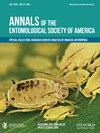Molecular Advances in Larval Fruit Moth Identification to Facilitate Fruit Export From Western United States Under Systems Approaches
IF 1.8
3区 农林科学
Q1 ENTOMOLOGY
引用次数: 1
Abstract
Abstract Molecular advances facilitate fruit export by improving rapid pest diagnosis by polymerase chain reaction (PCR) and advanced sequencing technology. Improved pest detection provides timely certification of the quarantine pest-free status in the commodity being exported, avoiding unnecessary commodity treatment. The U.S.–Japan Systems Approach to export fresh cherries from the Western United States that targets the codling moth, Cydia pomonella (Linnaeus) (Lepidoptera: Tortricidae), is used as an example. Suspect codling moth larvae interdicted at cherry packing houses are distinguished by PCR from other internal fruit moth larvae such as the oriental fruit moth, Grapholita molesta (Busck) (Lepidoptera: Tortricidae); lesser appleworm, G. prunivora (Walsh) (Lepidoptera: Tortricidae); cherry fruitworm, G. packardi (Zeller) (Lepidoptera: Tortricidae); and filbertworm, Cydia latiferreana (Walsingham) (Lepidoptera: Tortricidae). Identification is confirmed by sequencing the amplicon of a 301 bp region of the COI gene produced by PCR of the DNA from a suspect moth and comparing this sequence of COI gene sequences of other internal fruit feeders of pome fruit. This sequence comparison results in unambiguous pest identification. These findings are discussed in the context of systems approach research to meet evolving needs of phytosanitary requirements for global export of fruits.在系统方法下鉴定幼龄果蛾的分子进展以促进美国西部水果出口
摘要分子技术的进步通过聚合酶链反应(PCR)和先进的测序技术改进害虫的快速诊断,为水果出口提供了便利。改进的有害生物检测可以及时证明出口商品的检疫无虫状态,避免不必要的商品处理。以美国西部的鲜樱桃出口政策为例,该政策针对的是食腐蛾Cydia pomonella (Linnaeus)(鳞翅目:蛾科)。在樱桃包装厂截获的疑似冷蛾幼虫与其他内部果蛾幼虫如东方果蛾,Grapholita molesta (Busck)(鳞翅目:蛾科)进行了PCR区分;小苹果虫,G. prunivora (Walsh)(鳞翅目:扁桃科);樱桃果虫,G. packardi (Zeller)(鳞翅目:蛾科);和绢虫,Cydia latiferreana (Walsingham)(鳞翅目:蛾科)。通过对疑似飞蛾DNA PCR产生的COI基因301 bp区扩增子进行测序,并将该序列与其他梨果实内部取食动物的COI基因序列进行比较,证实了该鉴定。这种序列比较的结果是明确的害虫鉴定。这些发现是在系统方法研究的背景下讨论的,以满足全球水果出口植物检疫要求的不断变化的需求。
本文章由计算机程序翻译,如有差异,请以英文原文为准。
求助全文
约1分钟内获得全文
求助全文
来源期刊
CiteScore
4.90
自引率
0.00%
发文量
25
审稿时长
6-12 weeks
期刊介绍:
The Annals of the Entomological Society of America exists to stimulate interdisciplinary dialogue across the entomological disciplines and to advance cooperative interaction among diverse groups of entomologists. It seeks to attract and publish cutting-edge research, reviews, collections of articles on a common topic of broad interest, and discussion of topics with national or international importance. We especially welcome articles covering developing areas of research, controversial issues or debate, and topics of importance to society. Manuscripts that are primarily reports of new species, methodology, pest management, or the biology of single species generally will be referred to other journals of the ESA. The most important criteria for acceptance are quality of work and breadth of interest to the readership.

 求助内容:
求助内容: 应助结果提醒方式:
应助结果提醒方式:


